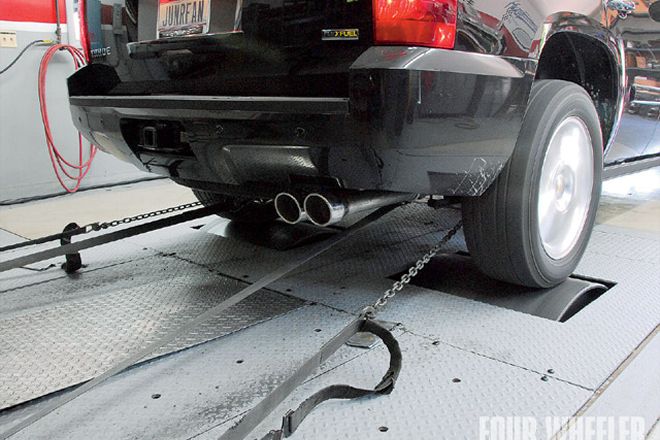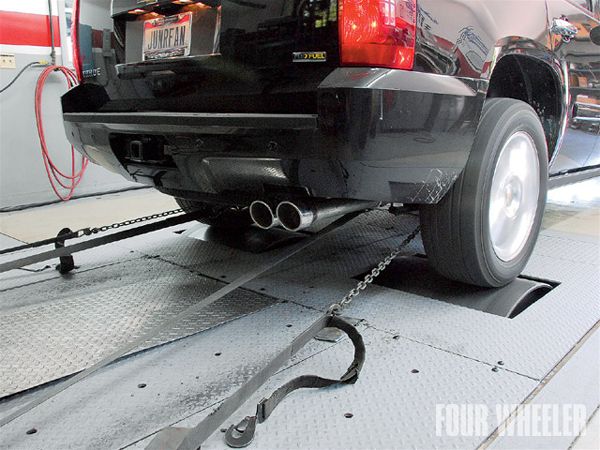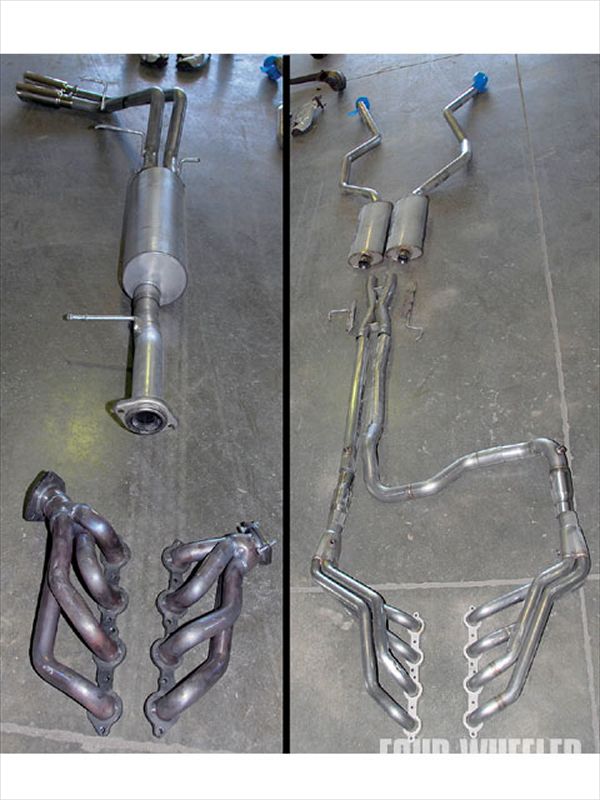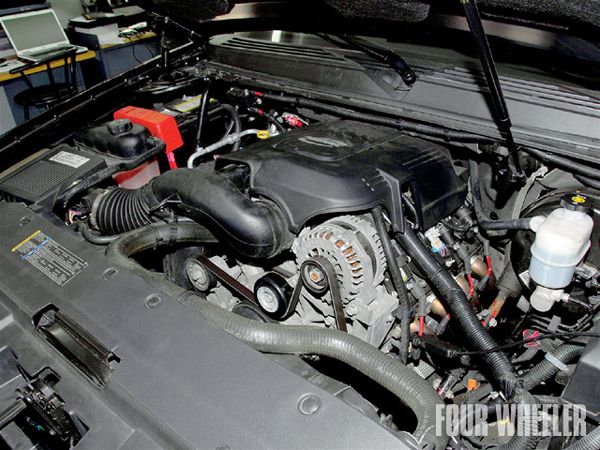

Conventional wisdom has it that long-tube headers offer more performance than short-tube headers, albeit at more expense and installation effort. We decided to test that conventional wisdom and share the results.
Stylin' Trucks, the well known retailer of just about everything truck-related, facilitated a test for us by supplying a set of Gibson shorty headers with an after-cat exhaust to match, as well as a set of the new Stainless Works long-tube headers and a full Stainless Works true dual exhaust system. Stainless Work's R&D technician, Vinnie Kitco, did the install work on both systems. We then teamed up with Hutter Performance, of Chardon, Ohio, to do the dyno testing, and Trevor Hutter provided a stock 2007 Chevy Tahoe with a 5.3L V8.
 The exhaust systems compared on the floor at the Stainless Works R&D shop. At left are the Gibson shorty headers and catback. On the right, the Stainless Works long tubes, cats and true dual system.
The exhaust systems compared on the floor at the Stainless Works R&D shop. At left are the Gibson shorty headers and catback. On the right, the Stainless Works long tubes, cats and true dual system.
Short vs. Long Tubes
The guiding principle behind headers is called "scavenging." By carefully choosing the length, diameter, and sometimes the way the header tubes are paired, the velocity of the exhaust gas pulses can create a "siphoning" effect behind them as they travel down the tubes. That helps clear more exhaust gas from the cylinder and creates a partial vacuum. When the intake valve opens, the cylinder can "inhale" a larger charge of air. With more air, an increased charge of fuel can be added for more power. Headers may also reduce pumping losses, making it easier for the piston to "push" the exhaust from the cylinder and out the pipe. Scavenging also works as the exhaust pulses move down the exhaust pipes.
Generally, the longer the individual tubes, the more scavenging occurs at lower speeds. In theory, this gives the long-tube headers a longer, broader torque curve that starts at a lower rpm. The shorties will be more suited to higher rpm, and perhaps stellar at one narrow rpm band where all the physics come together.
Enough theory...how about practicalities? Where the shorty headers shine is in the area of installation. Typically, they are no worse to install than a factory manifold, no matter how hard or easy that might be on their own. Because they most often use the factory Y-pipe, that part of the exhaust can stay in place.
 The competitors: On top is the factory manifold, which is somewhat tuned at least. In the middle is the Gibson GP129S stainless header that features 15/8-inch-diameter tubes. It fits 4.9L, 5.3L, 6.0L and 6.2L Gen IV V-8s in many GM truck and SUV platforms. On the bottom is the Stainless Works long-tube header, which has 13/4-inch tubes that are approximately 33 inches long. Thus far, it has been tested to fit only the 2007-09 Tahoe/Yukon applications, but it's likely to fit other Gen IV small-block applications as well, once Stainless Works get the chance to test fit them.
The competitors: On top is the factory manifold, which is somewhat tuned at least. In the middle is the Gibson GP129S stainless header that features 15/8-inch-diameter tubes. It fits 4.9L, 5.3L, 6.0L and 6.2L Gen IV V-8s in many GM truck and SUV platforms. On the bottom is the Stainless Works long-tube header, which has 13/4-inch tubes that are approximately 33 inches long. Thus far, it has been tested to fit only the 2007-09 Tahoe/Yukon applications, but it's likely to fit other Gen IV small-block applications as well, once Stainless Works get the chance to test fit them.
Long tubes are more often a bear, sometimes a raging grizzly of a bear, requiring removal of certain steering/suspension components, perhaps a crossmember, and then relocating cables, hoses, heat shields, etc. They may make later-model starter replacement more difficult. On top of that, because the factory Y-pipe is not used, you must find the means to install a Y-pipe (or dual pipes) and cats.
Most short-tube headers are CARB-compliant (California Air Resources Board, a measure of emission compliance used throughout the aftermarket industry). Fewer long tubes are CARB-compliant, due to the necessary catalyst changes and increased cost of getting them tested and certified.
Products And Installation
Headers are not easy to install on late-model rigs. Vinnie commented that while the Tahoe was not a "breeze," it proved to be on the easier side of the PITA-meter than some for both the Gibson and Stainless Works systems.
We pondered how to fairly test both headers. In the end we decided to use each company's most compatible exhaust system, realizing the Stainless Works true dual system would have a bit of an advantage. For Gibson, we used the (part number 5610) Dual Sport after-cat system, which features a single 3-inch mandrel-bent tube from the stock Y-pipe/cats, a Superflow muffler with dual 2.25-inch mandrel-bent outlets existing out the passenger side aft of the wheel, and the obligatory 3.5-inch stainless tips for style.
Stainless Works offered up a more elaborate true dual system, with dual free-flow cats, 2.5-inch mandrel bent stainless pipe, an "X-pipe" (a crossover to connect the two banks for flow and balance), and two 2.5-inch straight-thru and big polished stainless tips. Both pipes exit out the right rear.
 The GM 5.3L Gen IV small-block V-8 is a potent animal and capable of serious performance. The stock chassis dyno numbers were impressive, and there appears to be much more where that came from.
The GM 5.3L Gen IV small-block V-8 is a potent animal and capable of serious performance. The stock chassis dyno numbers were impressive, and there appears to be much more where that came from.
On The Dyno
The first impression was that the GM 5.3L GM really performs. The flywheel rating for this engine is 320 horsepower at 5200 rpm, and 340 lb-ft of torque at 4,200. Our baseline tests of 311 horsepower at 5,176 rpm and torque at 345 lb-ft at 4,076 were closer to what we usually see. Parasitical drivetrain losses usually account for 15 to 20 percent of flywheel power when testing on a chassis dynamometer. Trevor Hutter is a master on the dyno, so we assumed the dyno was reading a bit optimistically. Even with all the tests run on the dyno in this condition, the comparisons would all be accurate on a percentage gain basis. When we later asked about the numbers, Trevor called the dyno manufacturer for a calibration and found the dyno was reading about 14 percent high. Deducting around 14 percent from all the numbers in the charts below will give you a more comparably accurate figure in both stock and modified forms.
The Results
As with any aftermarket product, what you gain is directly proportional to how much better it is than the parts you replaced. Factory exhaust systems have radically improved over the years, and this Chevy illustrated that. The shorty system picked up 8 peak horsepower over stock, and while peak torque didn't change, the graph below will show some changes in its location in the rpm range. The long tubes picked up 21 horsepower over stock, and 13 over the shorties. Peak torque jumped 10 lb-ft over both stock and the shorties, but it was above both stock and the shorties all the way across the graph, especially at the upper end.
Unfortunately, late-model electronically controlled transmissions are smarter than we are and do not allow for much low-rpm loading, so our tests start in the midrange. Typically, long-tube headers offer big gains down low. The Stainless Works headers had large-diameter tubes relative to engine displacement, which tend to move the torque range (and the scavenging effect) into the higher rpm ranges.
Caveats And Conclusions
There are plusses and minuses in this comparison. The Stainless Works setup is the clear numbers winner. Plus, it's also got enough capacity to support a lot more tuning. On the other hand, the Gibson system is only 57 percent of the cost of the Stainless Works (full retail), it's 50-state CARB-legal (whereas the Stainless Works system is not), and it's easier to install.
In the end, we proved that long-tube headers still rule the performance, but in this modern era of tight bucks, tough fits, and emissions regs, short-tube headers are the more practical upgrade.
Line-by-Line Dyno Result Stock Gibson Stainless Works RPM HP TQ HP TQ HP TQ 3,126 170 283 186 312 191 320 3,226 192 312 195 318 198 321 3,326 202 319 204 321 207 327 3,426 212 {{{323}}} 212 324 215 330 3,526 219 327 221 329 225 334 3,{{{626}}} 232 335 229 332 233 337 3,726 {{{240}}} 338 241 339 243 343 3,826 249 341 248 341 252 346 3,926 255 341 257 344 260 348 4,026 263 342 264 344 268 350 4,126 270 344 271 344 276 351 4,226 277 343 278 344 283 351 4,326 284 344 284 345 291 353 4,426 288 341 288 342 298 353 4,526 294 340 293 340 305 353 4,626 298 338 299 339 311 353 4,726 301 335 303 337 315 350 4,826 305 332 308 334 319 347 4,926 307 327 310 329 322 343 5,026 309 322 314 327 325 339 5,126 309 316 316 324 327 334 5,226 311 313 317 318 330 332 5,326 311 307 319 314 332 327 5,426 All Done! 317 307 331 321 Peak Numbers Horsepower Torque (lb. ft.) Stock 311 @ 5,176 rpm 345 @ 4,076 rpm Gibson 319 @ 5,176 rpm 346 @ 4,276 rpm Stainless Works 333 @ 5,376 rpm 355 @ 4,476 rpm



